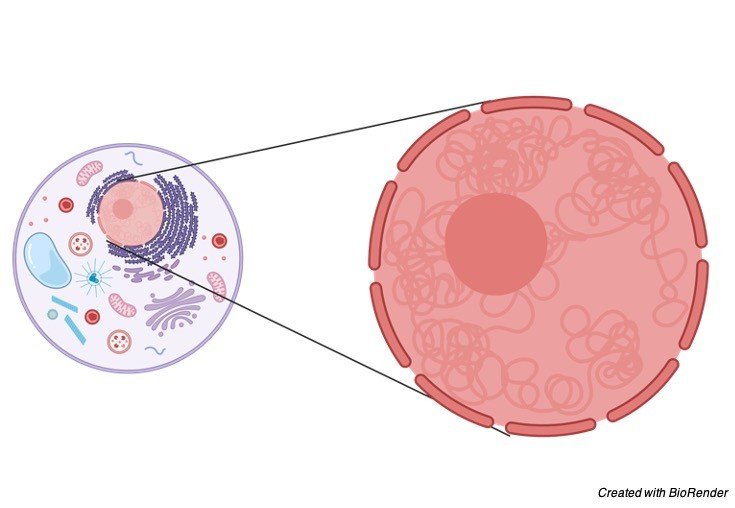What is Nucleus?
Nucleus (L. nucleus) is a particular two fold membrane attached protoplasmic body which contains all the hereditary data for controlling cell digestion and transmission to the successors.
A nucleus in the non-isolating or metabolic stage is called interphase nucleus. Like other cell structures, living perfect nucleus doesn’t show a lot of inward separation.
For an authentic investigation of the nucleus, the cells should be appropriately killed, fixed, and stained.
The nucleus is the biggest cell organelle.
However first saw by Leeuwenhoek in red blood corpuscles of fish, the nucleus was first concentrated in orchid root cells by Robert Brown in 1831.
Features of Nucleus
A nucleus is available in all living eukaryotic cells with the exception of develop strainer cells of vascular plants and red blood corpuscles of well evolved creatures.
Indeed, even here a nucleus is available during the beginning phases of their turn of events.
The presence of genetic data in the nucleus was demonstrated by crafted by Joachim Hammerling (1953) on single celled alga Acetabularia.
Total Count of Nucleus
Generally, cells are uninucleate, that is, they have a solitary nucleus.
The protistan Paramecium caudatum has two cores (bi-nucleate), macronucleus for controlling metabolic exercises of the creature and micronucleus possessing genetic data.
Multinucleate or polynucleate condition is found in certain cells of bone marrow, striated muscles, latex vessels, several parasites and green growth.
Multinucleate creature or protistan cells are called syncytial cells (e.g., epidermis of Ascaris) while in plants and growths they are called coenocytic cells (e.g., Rhizopus, Vaucheria).
Acellular sludge molds have a multinucleate protoplasmic body called Plasmodium.
Location of the Nucleus
Nucleus is typically found in the region of most extreme metabolic action in the cytoplasm.
Normally it is arranged in the mathematical focus of the cell.
In plant cells it is pushed to fringe position on one side because of the development of a huge focal vacuole.
It is peripheral in fat-putting away cells or adipocytes, and basal in glandular cells.
It is suspended in the focal vacuole by cytoplasmic strands in Spirogyra.
Composition of Nucleus
They have round border, and they seem oval or circular in plant cells having enormous focal vacuoles.
Plate like nucleus happen in the cells of squamous epithelium, lobed in white blood corpuscles and unpredictably stretched in silk turning cells of bugs.
DNA-9-12%. RNA-5%. Lipids-3%. Fundamental Proteins-15%. Corrosive proteins, impartial proteins and compounds 65%.
Hints of minerals like Calcium, Magnesium, Potassium and Sodium (Phosphorus is a constituent of DNA, RNA and corrosive proteins).
Structure of Nucleus
A regular interphase core is 5-25 pm in breadth. It is separated into five sections—atomic envelope, nucleoplasm, grid, chromatin and nucleolus.

i. Envelope
It limits the core outwardly. The envelope isolates the core from the cytoplasm.
It is comprised of two lipoprotein and trilaminar films, every one of which is 60-90A thick.
The internal layer is smooth.
The external film might be smooth or its cytoplasmic surface may bear ribosomes like the unpleasant endoplasmic reticulum.
The two films of the atomic envelope are isolated by an electron straightforward perinuclear space.
The space is 100—500 An in width.
The external film is regularly associated with endoplasmic reticulum. It contains an enormous number of pores or holes.
At times 10% of the envelope is involved by pores.
The two films of the envelope become ceaseless in the locale of pores.
Pores have complex construction.
They may have stomach, septum, attachment of electron thick material or nucleoplasmin, blebs or annuli.
Annuli are round structures around the pores.
The pores and their annuli structure a pore complex called annulated pore.
An annulated pore may have 9 chambers, one focal and eight fringe.
All things being equal, there might be an organization of granules and fibers.
The pores control the entry of substances to within or outside of the core, e.g., RNAs, ribosomes, proteins.
ii. Nucleoplasm (Nuclear Sap, Karyolymph)
It is a straightforward, semifluid and colloidal substance which fills the core.
It contains nucleosides and various compounds (e.g., DNA polymerase, RNA polymerase, nucleoside phosphorylase) which are needed for the blend and working of DNA, RNA, nucleoproteins, and so on.
A portion of the proteins present in nucleoplasm are fundamental for shaft arrangement.
iii. Matrix
It is an organization of fine fibrils of corrosive proteins that capacity as platform for chromatin.
On the fringe, beneath the atomic envelope, atomic framework shapes a thick stringy layer called atomic lamina.
Terminal finishes of chromatin filaments or telomeres are installed in atomic or stringy lamina.
Atomic framework comprises of two kinds of intermediate fibers, lamin An and lamin B.
Framework and lamina structure:
(I) Scaffold for chromatin,
(ii) Attachment locales to telomeric parts,
(iii) Mechanical solidarity to atomic envelope, and
(iv) Components of atomic pore complex.
iv. Chromatin
It is innate DNA-protein fibrillar complex which is named so because of its capacity to get stained with certain essential colours.
Chromatin happens as fine covering and looped filaments which seem to create an organization called chromatin reticulum.
Chromatin filaments are conveyed all through the nucleoplasm.
They are separated into two districts—euchromatin and heterochromatin.
Euchromatin is tight (10-30nm thick) delicately stained and diffused sinewy part which shapes the majority of chromatin.
Heterochromatin is more extensive (100 nm thick), hazily stained and consolidated granular part which is joined to a great extent on the euchromatin.
Contingent on the size of granules shaped by heterochromatin they are called chromocentres, karyosomes or bogus nucleoli.
v. Nucleolus (plural-nucleoli)
It was first found by Fontana in 1781, depicted by Wagner in 1840 and furnished with its current name by Bowman in 1840.
Nucleolus is a stripped, round or marginally sporadic construction which is connected to the chromatin at a particular area called nucleolar coordinator locale (NOR).
Regularly 1-4 nucleoli are found in a nucleus.
Up to 1600 nucleoli are accounted for in the oocytes of Xenopus.
A covering layer is missing around nucleolus.
Calcium is by all accounts fundamental for keeping up with its arrangement.
Nucleolus has four segments—undefined framework, granular part, fibrillar segment and chromatin.
Function of Nucleus
It is a fundamental and vital piece of the eukaryote cell.
It stores hereditary data in its DNA particles which can be given to offspring girl cells.
It additionally controls cell functioning.
i. Chromatin
It contains genetic material called chromatin. Chromatin is DNA-protein complex. It is made of various fine filaments that gather to shape chromosomes. Number of chromosomes is fixed for an animal types and possess genes/qualities.
ii. Hereditary Information
Chromatin some portion of nucleus has all the hereditary data that is needed for development and improvement of the organic entity, its proliferation, digestion and conduct.
iii. Cell Activities
It controls cell digestion and different exercises through the development of RNAs (mRNA, rRNA, tRNA) which control union of specific kind of proteins.
iv. Ribosomes
Ribosomes are shaped in nucleolus part of the nucleus.
v. Varieties
All varieties are brought about by changes in hereditary material present in the nucleus.
vi. Cell Growth and Maintenance
With the assistance of RNAs, nucleus coordinates the blend of some underlying proteins and synthetic substances needed for cell development and support.
vii. Cell Differentiation
It coordinates cell separation by permitting certain specific arrangements of qualities to work.
vii. Cell Replication
Replication of nucleus is fundamental for cell replication.
Citations:
- The protozoan nucleus. Mol Biochem Parasitol . Sep-Oct 2016;209(1-2):76-87.
- The cell nucleus. A study in Burgundy. Nucleus . 2019 Dec;10(1):213-217.
- Chromatin’s physical properties shape the nucleus and its functions. Curr Opin Cell Biol . 2019 Jun;58:76-84.
- The nucleus: keeping it together by keeping it apart. Curr Opin Cell Biol . 2017 Feb;44:44-50.
Share









